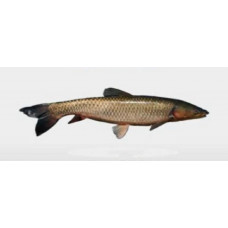The black carp (Mylopharyngodon piceus) is a freshwater fish of the carp family. It is the only species in the genus Amur. It reaches a length of more than 120 cm and a weight of 36 kg. It has a black colouring and large scales. It lives in the basin of the Amur, Ussuri, Khanka Lake and rivers of China. It matures at the age of 7-10 years. Spawns in June-July. Eggs are pelagic. It can lay up to 1 million eggs. Feeds mainly on molluscs and aquatic insects. Not numerous. Acclimatised to the European part of the country. It is an object of pond fish farming.
A large fish (length up to 1.2 m, weight - up to 30 kg) with an elongated body covered with large, densely packed scales. It owes its name to its dark colouring: the back of the Amur is almost black, the belly is slightly lighter, and all the fins are dark. A characteristic feature of this species are the very powerful pharyngeal teeth with developed chewing surfaces, which are used to crush the shells of molluscs. Externally it is very similar to the White Amur, but differs in being much darker in colouration. The black carp feeds mainly on molluscs, but also on insect larvae (dragonflies, mosquitoes) and other bottom-dwelling organisms. A 4-year-old amur can eat 1.4-1.8 kg of molluscs (drossia) per day. It does not form large schools. Black carp reaches sexual maturity at the earliest at the age of 7-9 years with a body length of more than 70 cm. It grows rapidly in southern waters, reaching a length of 55 cm in the 5th year of life. Widespread in the rivers of China and Taiwan.
During the summer, the black carp stays in slow-moving waterways, in places where molluscs accumulate - the so-called "mollusc fields" - and goes into the river channel to spend the winter. It spawns in the riverbed in the second half of June - early July during the summer flood. The main spawning grounds of this species are in the lower reaches of the Sungari River. The female lays 700-800 thousand swimming eggs from which swimming larvae hatch. The spawning and rolling of the eggs and larvae is usually timed to coincide with the spring flood, and the offspring are carried by the current in masses to floodplain lakes, still ponds and canals, where they find favourable conditions for fattening. If the spawning is slightly delayed, and the current is diverted from the flooded ponds to the canal due to the drop in water level, the larvae actively travel to their feeding places. The black carp grows very fast and lives for more than 13 years.
Black carp
Tags: black carp

